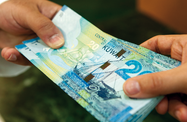Bank lending in Kuwait remained relatively flat during the first half of 2011, though this may have more to do with demand than banks being unwilling to extend credit.
According to the Central Bank of Kuwait, credit to residents amounted to KD25.2bn ($92.3bn) at the end of the second quarter of 2011, an increase of just 0.2% over the end of 2010. The year-on-year result was slightly better, rising by 1%. However, between 2008 and 2009 this same figure rose by 6%.
Michel Accad, the CEO of Gulf Bank, told OBG, “Today, the reason why you may not have larger growth in lending is because the borrowers are reluctant because of uncertainty. In a world of uncertainty, you try to reduce your borrowing. It is the demand for credit that has reduced, not the supply.”
Accad also noted that there is ample liquidity in the banking system, which continues to place downward pressure on interest rates. Indeed, lending remains muted in spite of a cost of borrowing that is historically low. According to Bloomberg, the three-month interbank interest rate in Kuwait has hovered around 0.81% for most of the past three months. This is lower than the prevailing rates in regional neighbours such as the UAE, Qatar and Bahrain.
While aggregate levels of credit may be growing slowly, lending to certain parts of the economy – including consumers and the real estate sector – is expanding more quickly. For example, personal facilities (excluding loans to purchase securities) exhibited moderate growth during the first seven months of 2011, rising by 4.1% to reach $22bn, representing around 24% of Kuwaiti banks’ loan portfolios. Majdi Gharzeddeene, the head of the investment research department at KIPCO Asset Management Company, told OBG that banks are targeting an increase in personal facilities because they are guaranteed by salaries.
According to a report from the National Bank of Kuwait (NBK), lending to the real estate sector – which made up 26% of bank loans in 2010 – fell KD41m ($150.3m) during the second quarter of 2011, but following a strong performance during the first quarter, growth for the first six months remained positive at 2%. On the other hand, loans to non-bank financial institutions – which include the troubled investment companies – declined by 6% during the first half of 2011. This sector accounted for 11% of banks’ loan portfolios in 2010.
Although credit demand remains subdued, NBK, the country’s largest bank, reported in July that its net profits for the first half of 2011 increased to KD146.7m ($537.4m), a rise of about 1% over the previous year. On the other hand, second quarter net profits amounted to just KD65.9m ($241.4m), a decline of 4.5% from the same period in 2010. This was also lower than expectations, with analysts polled by Reuters projecting net profits of KD79.9m ($293m).
In March 2011 the CEO of NBK, Ibrahim Dabdoub, told Reuters that he expected profits in 2011 to be similar to those of the previous year, saying, “Overall our bottom line will be more or less similar to the $1.1bn last year, which is not bad.” Dabdoub also noted that the bank was targeting a 10-15% increase in lending in 2011, but he added, “The loan portfolio of most banks in the region has been flat. We haven’t seen any economic activity to stimulate growth significantly.”
One factor that could stimulate bank credit, at least in Kuwait, would be the implementation of the National Development Plan (NDP), a four-year economic programme that was approved by the Kuwaiti parliament in February 2010. The NDP calls for several hundred projects and initiatives in areas such as housing, health care and transport, with total spending projected to reach an estimated $108bn. About half of this is expected to be financed by banks.
However, the implementation of the development programme has been slower than expected. In July ratings agency Fitch reported that its outlook for the Kuwaiti banking sector was stable, but it cautioned that the spending goals of the NDP were unlikely to be met in 2011, which could reduce the plan’s expected boost to the banking sector. Similarly, Goldman Sachs analyst Waleed Moshin wrote in a July 25 report on the Commercial Bank of Kuwait that “loan growth in Kuwait remains muted, with delays in the implementation of development projects”.
Although Kuwait’s banks are stable and well capitalised, their profitability is at least in part constrained by limited lending opportunities. However, this will likely change in the near future as the government pushes forward with the implementation of the NDP.

